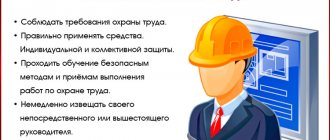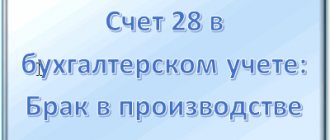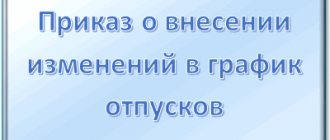Author of the article: Anastasia Ivanova Last modified: January 2020 449
An industrial accident is a deterioration in the health of an employee as a result of performing his job duties specified in an agreement concluded with the employer. Such situations are regulated by labor legislation and Federal Law No. 125 of 1998. These documents clearly define the employer’s responsibilities in the event of an accident.
Federal Law No. 125-FZ of July 24, 1998
“On compulsory social insurance against accidents at work and occupational diseases” (more details)
Basic concepts about injuries
In production, no one can be insured against the risk of injury in connection with the performance of work functions.
In accordance with labor legislation, the following injuries are identified that can be recognized as industrial:
- bruises, lacerations, cuts;
- open and closed fractures;
- bites received from insects;
- burns or frostbite;
- other damage that is associated with the loss of the ability to carry out work activities.
Attention! All injuries can be classified into the following categories:
- minor injuries , which do not result in permanent disability. As a rule, such injuries are considered: sprains, bruises, scratches or abrasions;
- Moderate injuries : These injuries are more significant and are followed by disability. Such injuries may include fractures (including open ones), spinal bruises and other injuries. For such injuries, as a rule, the person is treated in a hospital;
- severe injuries . In the presence of such injuries, treatment takes a long period of time, taking the employee away from performing production tasks for a long time.
The degree of severity is determined only by a medical professional in accordance with a special reference book.
Where can an accident happen?
An accident that occurred at work must be registered in the appropriate manner by the management of the organization.
Accidents can occur in the following circumstances:
- in case the employee performs his direct labor duties at the enterprise;
- during an employee’s business trip;
- on the shift to which the employee was sent;
- during the lunch break (if the employee is on the employer’s premises).
An employee has the right to claim payment only if such an injury is recognized as work-related in the appropriate manner.
Actions of an employee in case of an accident at work
The list of actions that need to be taken by both the victim and the witness depends on the situation, the circumstances of the injury and the number of people injured.
The injured worker must first of all:
- call someone to help him;
- if possible, seek medical help as soon as possible;
- report information about the incident to the head of the enterprise. Further, within a month after filing such an application, the employer must conduct an investigation.
When an employee was not injured as a result of production service, but became an eyewitness to the incident, he must carry out the following list of actions:
- take measures that would reduce the risk of being exposed to the damaging factors that led to the incident. For example, when another employee was injured by electric current, the witness must use a dry object that does not conduct current to remove the source of danger, and only after that carry out other actions;
- determine whether he can do anything for the victim without attracting help from other workers;
- if possible, free the victim from the target;
- provide first aid;
- report to the medical service or call a qualified medical professional;
- convey information about the incident to the managers of the enterprise;
- take actions aimed at preserving the entire situation that occurred at the scene of the incident. If possible, an eyewitness should record the situation in a photo or video.
Please note that these actions cannot be assigned as employee duties. However, when performing such actions, the employee will help the victim.
Employer's procedure: step-by-step instructions
In 2020, if there is an accident at work, the employer must carry out the following list of actions.
Step 1. First aid to the victim
If an accident occurs at an enterprise, first of all measures should be taken that are aimed at providing first aid to the victim. Assistance must be provided in such a way as not to pose a danger to other persons. If there is a threat to the safety of all workers, it should be eliminated first, and only then first aid should be provided.
Example
In 2013, in St. Petersburg, at a production facility that was engaged in cleaning tanks from toxic materials, one of the workers had a protective mask rupture. The second worker, having lost contact with him, entered the tank without respiratory protection and also died.
Attention! Our qualified lawyers will assist you free of charge and around the clock on any issues. Find out more here.
Step 2. Call an ambulance and notify government agencies
After providing the injured employee with first aid (an ambulance may be called to production or the employee may be transported to the hospital by the employer), the latter is obliged to take a list of actions established by labor legislation.
First of all, the relevant organizations must be notified in a timely manner.
| Any NS | Social Insurance Fund at the place of registration of the employer | In 24 hours |
| Group or fatal |
| In 24 hours |
| NS, which over time became severe or fatal |
| Within 72 hours from the date of receipt of information |
Important! Each notification is submitted in accordance with the prescribed form:
- The FSS is notified in the form approved by Order of the FSS of the Russian Federation dated August 24, 2000 No. 157;
- Notifications to other organizations must be completed in accordance with Resolution of the Ministry of Labor of Russia dated October 24, 2002 No. 73.
It is necessary to pay attention to the fact that the delivery of the employee to a medical facility or home is carried out at the expense of the employer. This is contained in Art. 223 Labor Code of the Russian Federation. Remember, just because an injured worker says they feel fine does not mean they do not need qualified medical attention.
Every action carried out by the employer must comply with regulations, which means that he must take measures aimed at providing medical assistance to the employee, regardless of the desire of the employee himself.
Example
Some internal bleeding is not always pronounced. For example, parenchymal bleeding is characterized by symptoms that cannot be diagnosed independently.
During bleeding, the patient experiences slight drowsiness, dizziness, then the pulse quickens and the blood pressure rises. After some time, the person falls into a coma and then dies.
Step 3. Keep the scene of the incident unchanged
Remember! The accident site must be fenced. None of the employees have the right to be there. It is not allowed to move objects at the scene of the incident. If possible, this place should be photographed or videotaped.
The person in charge of the accident scene should not wonder how to conduct the investigation. The main task of such a person is to preserve the place in the same form in which the accident occurred.
Step 4. Selecting a commission
One of the employer’s responsibilities in the event of an accident at work is to form a commission to investigate. The investigation procedure is established in a number of regulatory documents.
The following persons should be included in the commission:
- employer representative;
- an employee whose job responsibilities include organizing labor safety;
- employee representative (trade union leader).
Based on internal regulatory documents, other persons may be included in the commission.
Please note! If the employer is an individual, the commission should include the following persons:
- the employer himself;
- a representative of an employee who was injured at work;
- independent expert in the field of occupational health and safety.
When an accident in which several workers were injured or a fatality is subject to investigation, the following persons should be included in the commission:
- a representative of the state labor safety inspectorate, who will be the chairman of the commission;
- representative of the administration of the city or subject;
- representative of the trade union body formed in the subject;
- representative of the injured or deceased.
A complete list of cases in the presence of which certain persons are included in the commission is established by Art. 229 Labor Code of the Russian Federation.
Step 5: Investigation
The investigation at the enterprise is regulated by the provisions of the Labor Code of the Russian Federation and Resolution of the Ministry of Labor and Social Development of Russia dated October 24, 2002 No. 73.
The following time frames for the investigation have been established:
- Minor cases of injury, once reported, must be investigated within 3 days;
- Severe cases of injury, as well as cases with a fatal outcome, are investigated within a period of no more than 15 days, with a possible further extension of the period, but not more than 15 days;
- Cases about which the employer was not informed in a timely manner or in connection with which the employee’s health disorder was not immediately identified are investigated in accordance with the general procedure after receiving a statement from the employee, that is, within 30 days.
Attention! During the investigation process, the duties of the commission include the following actions:
- interviewing witnesses to the case, the head of the enterprise, the injured person, drawing up a protocol in form 6, approved. Resolution of the Ministry of Labor No. 73 of October 24, 2002;
- inspection of the scene of the incident, drawing up a protocol in form 7, approved. Ministry of Labor and Social Development of the Russian Federation in the Resolution dated October 24, 2002;
- establishing all the circumstances of the accident;
- identifying the causes and factors that contributed to the situation;
- defining the case as production;
- identification of persons who are guilty of this incident;
- preparing a conclusion on measures to prevent similar cases in the future;
- determining the degree of guilt of the victim himself;
- drawing up an accident report in the appropriate form, which must be signed by each member of the commission and the head of the enterprise.
The employer is obliged to assist the commission by taking the following actions:
- provision of an office for investigation;
- provision of a vehicle for travel;
- providing access to various types of communications;
- providing the opportunity to record the scene of the incident;
- involving experts in the investigation;
- carrying out the necessary laboratory tests (if necessary).
In addition, the employer is required to obtain a report prepared by a medical commission on the severity of the injuries received by the employee. Such a conclusion must correspond to the form specified in Order of the Ministry of Health and Social Development No. 160 of February 24, 2005.
Step 6: Once the investigation is complete
After the investigation of an industrial accident has been completed, the commission must draw up an appropriate act, which will indicate who is found to be at fault for the incident, and whether this incident is recognized as a work-related injury.
Important! The act must be drawn up in three identical copies:
- one form of the report along with the investigation materials is transferred to the FSS.
- the second copy is handed over to the employee or his representative.
- the third copy must be kept at the enterprise for 45 years.
Step 7. Report
Every enterprise is required to keep accident logs. They contain information about all traumatic incidents that occurred at work. Once the journal is completed, it is stored for at least 45 years.
Watch the video. Accident at work:
https://youtu.be/Ea8NkAOduCc
Report on form 7-injuries
Once a year, organizations are required to submit to the Rosstat department information regarding the number of occupational injuries received by workers at work, as well as the number of identified occupational diseases of workers.
In this regard, Form 7-injury was developed and approved (Appendix No. 2 to Rosstat Order No. 216 dated June 19, 2013).
Since 2020, the procedure for investigating accidents at the enterprise has not changed, however, by Order of Rosstat dated August 10, 2018 No. 493 “On approval of statistical tools for organizing federal statistical monitoring in the field of healthcare, industrial injuries and population migration,” a new reporting form was introduced.
Please note! This form must be submitted once every three years no later than January 25 by all legal entities and enterprises that carry out economic activities, with the exception of the following organizations:
- carrying out financial and insurance activities;
- carrying out public administration and ensuring military security, social security, education;
- running a household.
How the Act is drawn up in form N-1
The completed Report in Form N-1 is the final document regarding the investigation of an industrial accident.
Execution of the Act in form N-1
Recommendations for filling:
- The incident that happened to the employee is briefly and concisely described.
- The following is a description of the testimony of eyewitnesses and the victim himself.
- It is indicated which point from the regulatory document was violated by the victim and his immediate supervisor.
- Afterwards, by decision of the commission, the percentage of guilt of the injured employee and the manager is prescribed.
- The prepared document is signed by the members of the commission and approved by the chairman of the commission.
The act is stored in the enterprise archive for 45 years, which meets the requirements of legislative documents.
What injuries are subject to investigation?
Every accident that occurs at work is subject to mandatory investigation by the employer. In this case, the investigation must be carried out in accordance with the requirements imposed by law.
Attention! An investigation must be conducted into every injury sustained by an employee on the premises of the enterprise, including the following injuries:
- received during fights, animal (insect) bites;
- received in connection with electric shock, lightning;
- associated with overheating, frostbite or burns;
- other injuries that occurred to the employee during the performance of job duties.
To recognize an injury as a work-related injury, certain conditions must be met:
- the injury was sustained by the employee while performing his direct duties during working hours on the territory of the organization (it does not matter whether it occurred during a break or not);
- the injury was sustained while traveling to or from work, when the employee was traveling in a company vehicle;
- the injury occurred while the employee was on a business trip;
- The injury was sustained during a shift.
Every case of injury or injury at work, after being recorded, is subject to investigation.
What should a leader do?
Actions of a manager in case of an accident at work
Upon receipt of information about the occurrence of an accident by the manager in the area entrusted to him, the latter must take the following actions in the event of an industrial accident:
- Notify senior management and the occupational safety representative.
- Assess the condition of the victim and immediately arrange for his delivery to the nearest medical facility, accompanied by a work colleague. In this case, it is necessary to prepare a request about the severity of the injury received.
- Assess the condition of the workplace where the incident occurred and give instructions to other employees: either fence off the area and not touch anything or eliminate the danger to others.
- Next, you should wait a pause for specialists to determine the severity. This is necessary to establish how the investigation will be conducted, including which committee should be appointed.
- The labor protection service must send information about the incident to social security. The time allotted for this is no more than a day, and the need is to calculate a percentage of payments to the victim.
What documents regulate the actions of employees at the enterprise?
Important! The list of actions that must be carried out by an employee in the event of an accident is specified in the following regulations:
- in the labor protection instructions for individual professions or types of work. They indicate both a list of actions in emergency situations and rules for providing medical care before the arrival of medical services;
- in the production instructions. Such a regulatory document regulates the activities of industrial safety areas. They may also indicate the actions that must be taken in the event of an industrial injury;
- in enterprise standards. Such acts are considered local, since they are developed directly by the employer. They indicate safety requirements, a list of first actions in the event of an incident;
- in the accident investigation provisions. Such provisions are considered basic because they contain specific rules regulating the actions of employees in the event of an accident. The regulations provide for report forms that contain a list of information about the accident that occurred.
Meeting deadlines is one of the employer’s functions
The time frame for the NSP investigation is strictly defined by Art. 229.1 Labor Code of the Russian Federation. They range from 3 days to 1.5 months, depending on the severity of the harm caused to the victim’s health:
- NSP investigations are limited to a 3-day period if the victims escaped with minor injuries.
- The period for investigating the circumstances of a fatal industrial accident should not exceed 15 days.
- The time increases to 1 month if the employer did not have information about the accident (was not notified in a timely manner about the accident) or the victim did not immediately lose the ability to work after the accident. The starting point for organizing an investigation in this case will be a statement from the victim or his representative.
- The period for investigating the circumstances of an employee’s occupational injury will be extended for another half a month if additional verification of the circumstances is required (obtaining medical and other reports).
Legislatively established deadlines may be extended beyond the specified time periods. This can happen if it is impossible to complete the investigation on time due to the fact that the circumstances of the NSP require the involvement of investigative bodies, inquiries, judicial or other institutions that carry out the examinations necessary in such cases. To complete the investigation, it will be necessary to increase the period, which is determined taking into account the decisions taken by these bodies or in agreement with them.
What compensation is paid to an employee?
An employee who is injured while performing his or her duties has the right to contact the head of the organization with a claim for monetary compensation. This provision is contained in Art. Federal Law dated December 29, 2006 No. 255-FZ.
Damages associated with the loss of the opportunity to work are immediately subject to compensation:
- the employee is paid wages;
- medical expenses are reimbursed;
- expenses associated with rehabilitation activities.
In addition, the employer is obliged to compensate the employee for moral damage caused as a result of the accident.
In the event of the death of an employee as a result of an accident at work, compensation must be paid to the relative of the deceased.
Providing first aid by the employer
Regardless of the specifics of production, if an accident occurs, the employer is obliged to provide first aid to the victims. Such an obligation is described in Art. 228 of the Labor Code of the Russian Federation. Moreover, he must either provide it or organize the necessary procedures. And the word “immediately” appears in this article for a reason. That is, the employer or his representative does not have the right to postpone such an urgent measure until later.
The same article states that in case of necessity and serious injuries, it is the employer or his representatives who must, at their own expense, deliver the victim to a hospital or other medical facility. In particular, if necessary, the manager must use personal transport or order transportation for the victim.
Management’s responsibilities will also include taking measures to prevent new victims. If there is a risk of an emergency or even one has occurred, it is the employer who is obliged to do everything possible to ensure that no one else gets hurt. An accident can quite often lead to a large number of not only casualties, but also material losses for the organization.
An accident victim may, of course, refuse hospitalization or assistance as such. However, such a refusal should not be accepted, because the person may be in a state of shock. Keep in mind that damage can be serious even if the person feels relatively normal. A medical examination will be beneficial to all parties to the incident.
How to ensure safe work
It is obvious that it is impossible to foresee all possible cases of injury to workers at work.
However, safety and security engineers offer the following advice to employers to reduce the risk of accidents:
- First of all, the enterprise must have a labor protection engineer or a department that deals with this.
- An engineer in such a department should devote the bulk of his time to the development and implementation of preventive measures aimed at reducing the risk of accidents. In the course of his work, the engineer must visit enterprise facilities and identify safety violations. If violations are detected, conversations must be held or an order issued;
- the employer must monitor safety violations identified by the service. After tracking, preventive conversations should be held with the violator, and in case of repeated violations, disciplinary measures should be taken. The employer must ensure that the enterprise develops and applies methods that will reduce the risk of accidents.
Watch the video. Work injury: workers' rights and employer's responsibilities
https://youtu.be/xHdbbOGyqbI
Dear readers of our site! Our articles talk about typical ways to resolve legal issues, but each case is unique.
If you want to find out how to solve your specific problem, please contact the online consultant form on the right. It's fast and free! Or call us at :
+7-495-899-01-60
Moscow, Moscow region
+7-812-389-26-12
St. Petersburg, Leningrad region
8-800-511-83-47
Federal number for other regions of Russia
If your question is lengthy and it is better to ask it in writing, then at the end of the article there is a special form where you can write it and we will forward your question to a lawyer specializing specifically in your problem. Write! We will help solve your legal problem.
Emergency prevention measures
The head of the company must use various methods to prevent the occurrence of such events. To do this, perform the following steps:
- all employees of the enterprise are notified of the occurrence of an emergency;
- the source of danger is localized and neutralized;
- about the threat of an emergency, a message is transmitted to the Ministry of Emergency Situations, the police and the fire service;
- a high alert mode is introduced;
- the optimal level of response is established.
Other measures may be applied to protect personnel from possible unforeseen situations. Before work related to accident prevention begins, employees are briefed. All team members must be able to use emergency procedures. They are equipped with personal protective equipment, which includes special clothing, shoes, gas masks or other similar items.
https://youtu.be/JhV6TvMInvI
Employer under Art. 228 of the Labor Code has many obligations in the event of an accident in the company. He must assist the employee and investigate the incident. Measures are being taken to prevent such emergencies. Government authorities are notified of each such event, otherwise the owner of the company will be prosecuted.








